Applying Feng Shui principles to a children’s room is a thoughtful way to promote a nurturing environment where your child can grow, learn, and feel safe. A well-organized and balanced room can positively influence a child’s well-being, behavior, and ability to focus, while also ensuring restful sleep and emotional security. In this article, we will explore how to implement Feng Shui principles in a child’s room to create a space that supports their health, happiness, and development.
1. Bed Placement for Security and Restful Sleep

Just like in any other room, the position of the bed is one of the most important factors in creating a balanced Feng Shui layout in a child’s room. The bed should be placed in the “commanding position,” where the child can see the door from their bed without being directly in line with it. This positioning gives the child a sense of control and security, helping them feel more relaxed during sleep.
Additionally, avoid placing the bed under a window, as this can create disrupted energy and make it harder for the child to get a restful night’s sleep. The head of the bed should be positioned against a solid wall to provide stability and support.
Key Tips:
- Place the bed so that the child can see the door without being directly in front of it.
- Avoid positioning the bed under a window to ensure restful sleep.
- Ensure the head of the bed is against a solid wall for support.
2. Creating a Calm and Focused Study Space
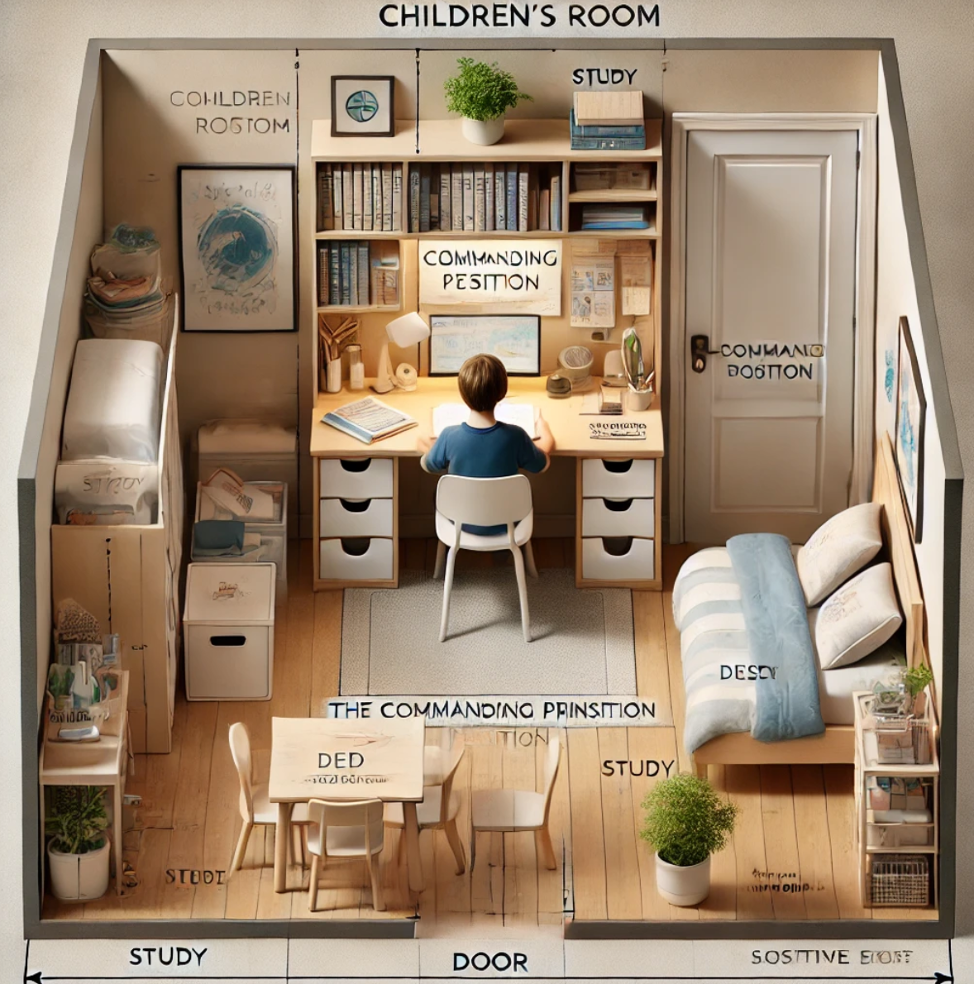
Children need a designated area for learning, drawing, and creative activities. In Feng Shui, the desk or study area should be placed in a way that encourages focus and concentration. Ideally, the desk should also be in the commanding position, where the child can see the entrance to the room while working. This positioning helps them feel in control and minimizes distractions.
Keeping the desk free of clutter is essential for maintaining focus. Use storage solutions like drawers, shelves, and containers to keep books and supplies organized. Introducing a small plant on the desk can also enhance the energy of the space, promoting a peaceful and focused atmosphere for study and creativity.
Key Tips:
- Place the desk in a position where the child can see the door while working.
- Keep the desk organized and clutter-free to encourage focus.
- Add a small plant to the desk area to promote positive energy.
3. Balancing Yin and Yang Energy in the Room
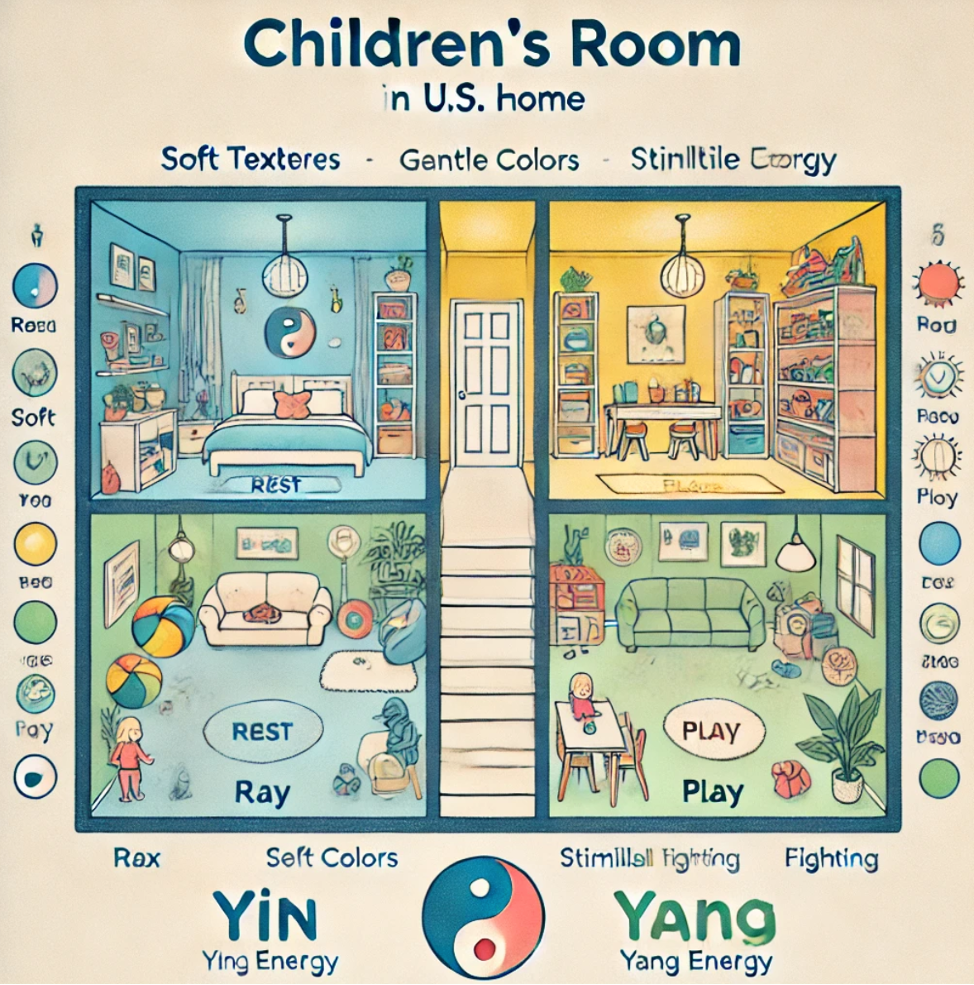
In Feng Shui, the balance between Yin (passive, calming) and Yang (active, energetic) energy is important, especially in a child’s room. A room that is too Yin may feel too quiet or dull, while a room that is too Yang could feel overly stimulating and chaotic. It’s important to find a balance that promotes both relaxation and creativity.
Yin energy can be introduced through soft textures, gentle colors like pastel blues or greens, and low, warm lighting. Yang energy, on the other hand, can be encouraged with bright colors, stimulating toys, and vibrant decorations that inspire activity and play. Try to create zones in the room: a calming area for rest and reading, and an energetic area for playing and learning.
Key Tips:
- Use soft textures and calming colors to promote relaxation (Yin energy).
- Incorporate bright accents and vibrant toys to enhance activity and creativity (Yang energy).
- Create separate zones in the room for rest and play to maintain balance.
4. Using Colors to Enhance Growth and Creativity
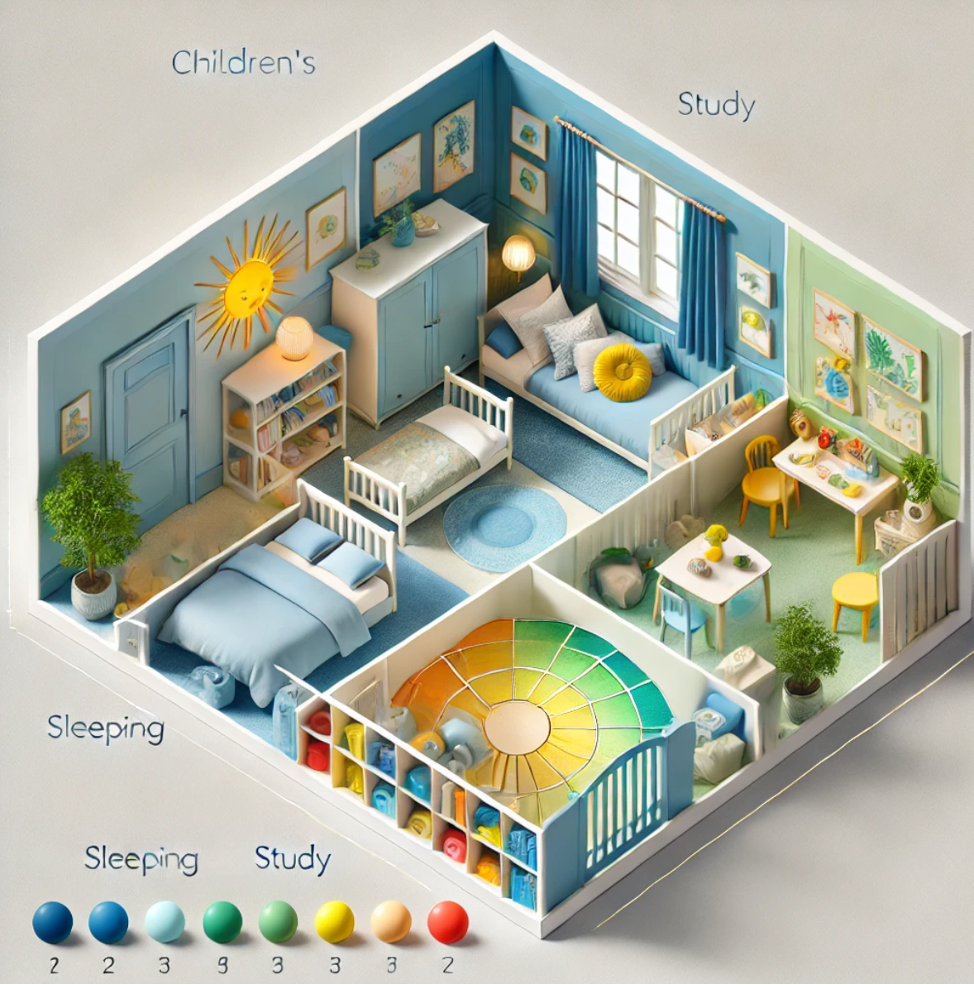
Colors play a significant role in Feng Shui, especially in a child’s room. Choosing the right color palette can encourage growth, creativity, and emotional well-being. Below are some Feng Shui color recommendations for a child’s room:
- Blue: A calming color that promotes relaxation and tranquility. Ideal for sleeping and reading areas.
- Green: Represents growth, renewal, and vitality. A great choice for study areas or creative corners.
- Yellow: A happy, stimulating color that enhances energy and focus. Best used in moderation for play areas.
- Pink: Soft, nurturing, and soothing. Good for promoting feelings of love and security.
It’s essential to balance bold colors with neutral or pastel tones to avoid overstimulation. Adding color through accents like pillows, rugs, or wall art allows for flexibility and keeps the room dynamic without overwhelming the space.
Key Tips:
- Use blue and green tones in study and relaxation areas to promote focus and calm.
- Introduce yellow in play areas to enhance creativity and activity.
- Balance bright colors with soft neutrals to maintain a harmonious environment.
5. Organizing the Room for Free Flow of Energy
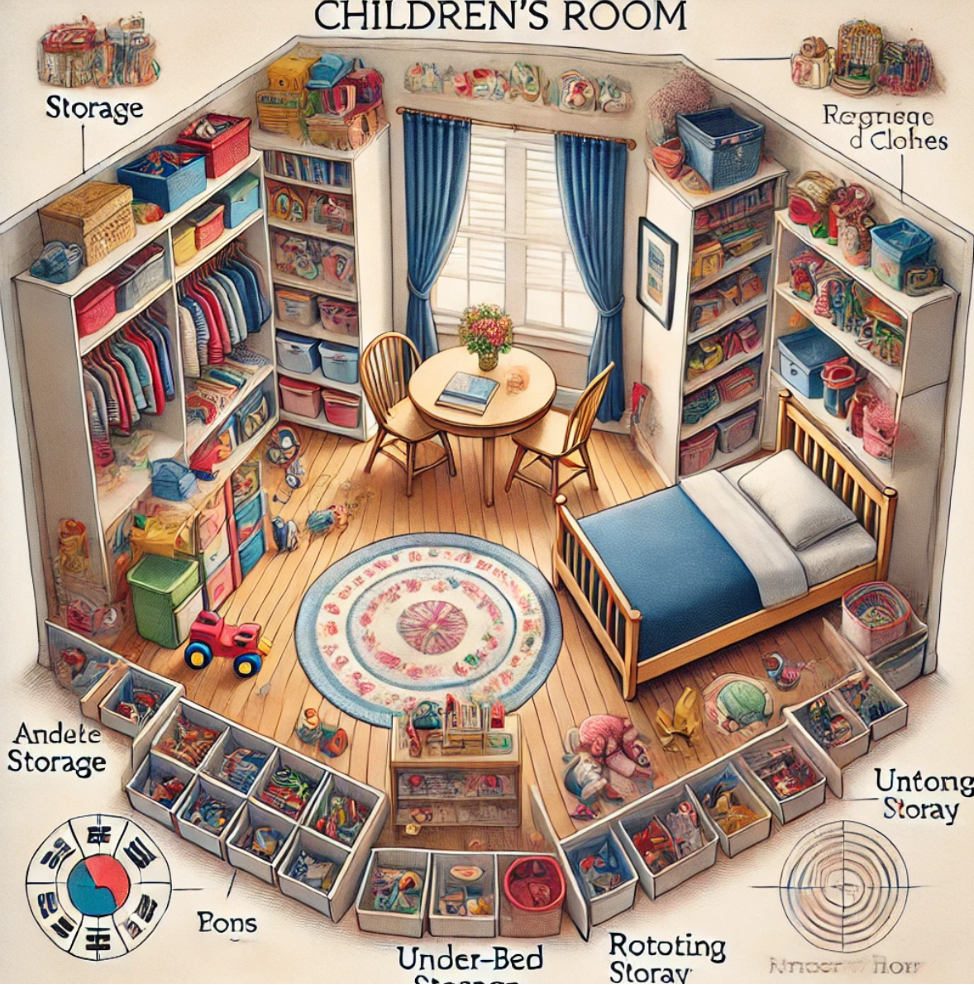
Clutter is one of the biggest obstacles to maintaining good Feng Shui. In a child’s room, it’s essential to keep toys, books, and clothes organized to allow the free flow of energy. Storage solutions such as toy bins, shelves, and under-bed storage can help keep the room tidy.
Additionally, it’s important to rotate toys to prevent clutter and to ensure that the room feels fresh and inviting. Encourage your child to participate in organizing their space by making it easy for them to put things away themselves.
Key Tips:
- Keep toys, books, and clothes organized to allow energy to flow freely.
- Use storage solutions like shelves, bins, and drawers to minimize clutter.
- Rotate toys regularly to keep the space feeling fresh and dynamic.
6. Incorporating Natural Elements
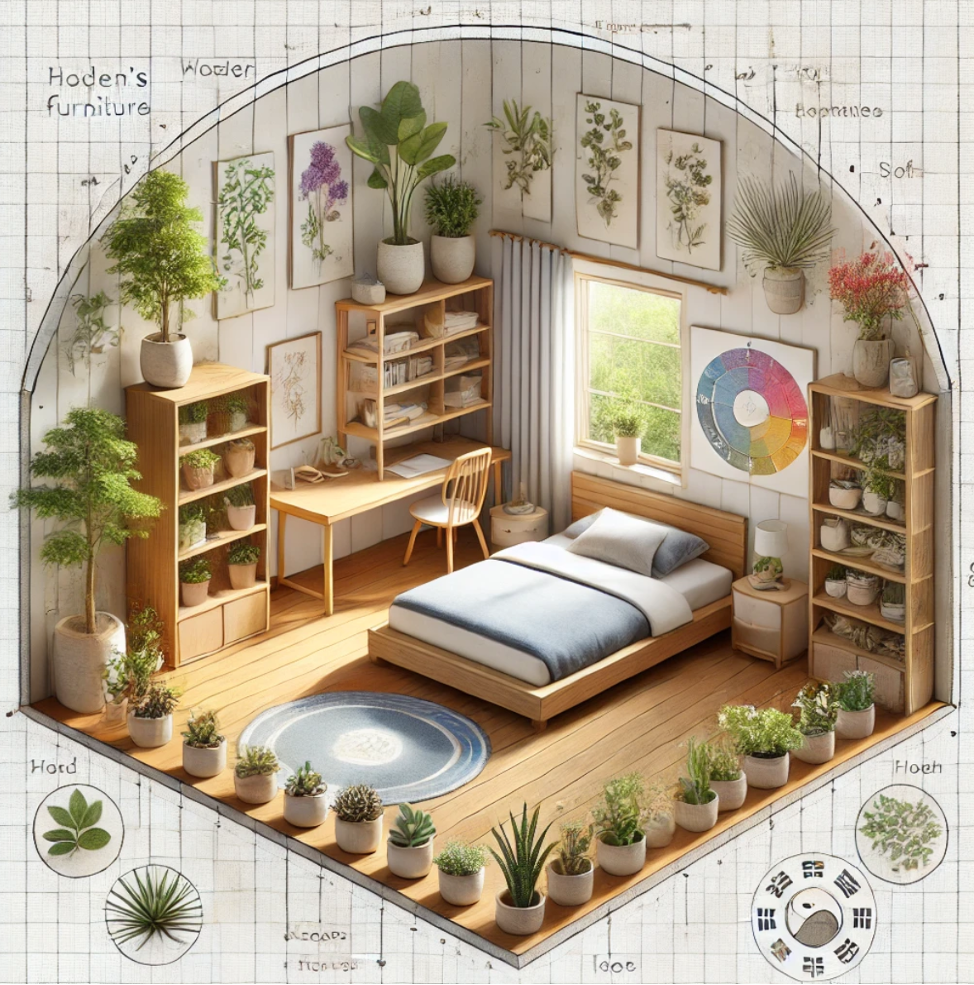
In Feng Shui, the five elements—Wood, Fire, Earth, Metal, and Water—should be balanced in any space, including a child’s room. Incorporating natural elements like wood or plants can create a calming and nurturing environment. Wooden furniture, such as a bed frame, desk, or shelving, brings in the Wood element, which symbolizes growth and vitality.
Adding plants to the room can enhance the energy flow, improve air quality, and provide a sense of responsibility for the child. Choose child-friendly plants like spider plants or succulents, which are easy to care for and add a sense of nature to the space.
Key Tips:
- Use wooden furniture and decor to bring in the Wood element, which promotes growth.
- Add child-friendly plants to improve energy flow and air quality.
- Balance natural elements with soft textures and materials to create harmony.
7. Personalizing the Space with Meaningful Decor
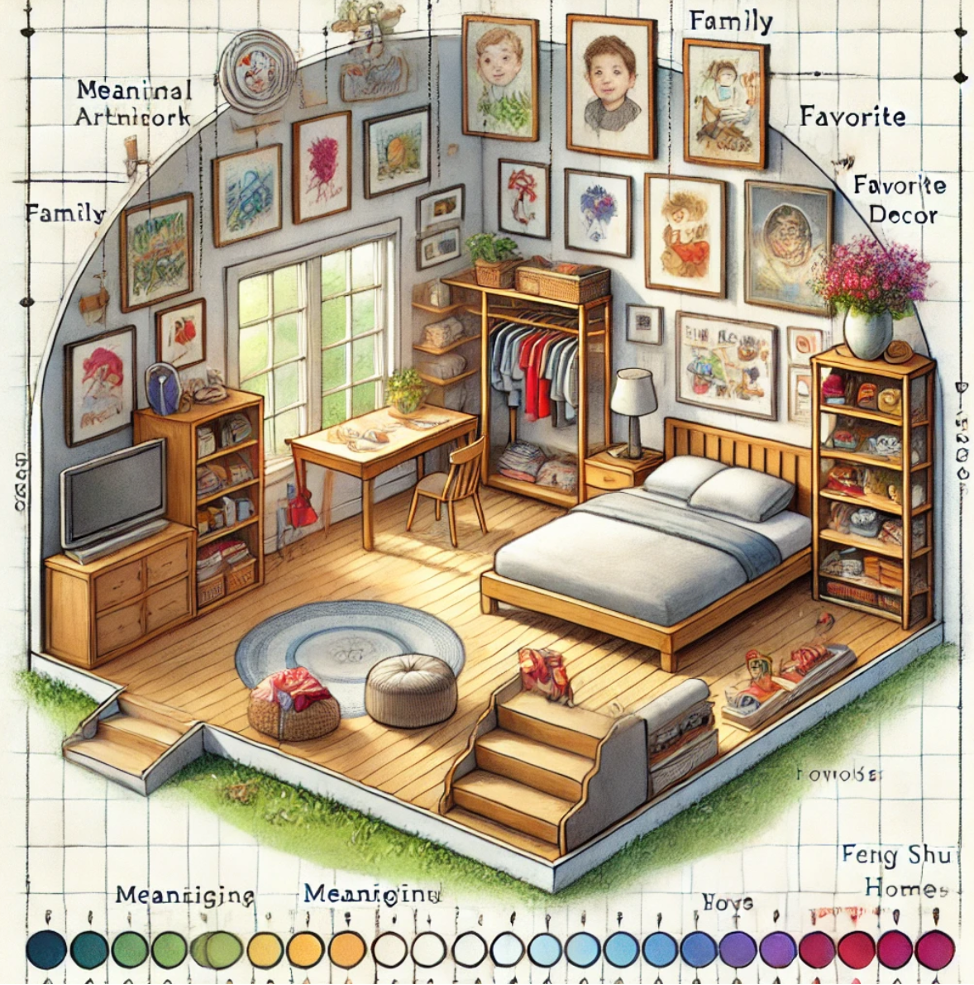
Children should feel connected to their room, and one way to enhance that connection is by personalizing the space with meaningful decor. Displaying the child’s artwork, favorite toys, or photographs of family and friends can make the room feel special and unique.
Incorporating personalized items helps the child feel more grounded and supported. However, it’s important not to overwhelm the space with too many decorations. Use a few key pieces that resonate with the child’s interests and encourage a sense of security and pride in their environment.
Key Tips:
- Personalize the room with the child’s artwork, favorite toys, or photos.
- Choose decor that resonates with the child’s personality and interests.
- Avoid cluttering the room with too many decorations; keep the space meaningful and balanced.
Conclusion
Designing a Feng Shui children’s room is about creating a space that supports the child’s physical, emotional, and mental growth. By balancing the placement of the bed, organizing the space, incorporating the right colors and natural elements, and adding personalized touches, you can create a harmonious environment that nurtures creativity, focus, and rest. With a few simple Feng Shui adjustments, you can transform your child’s room into a place where they can thrive and feel safe.

